Date posted: September 10, 2009
– Download E-Flite Blade mSR Review as PDF –
Taking a look at the E-Flite Blade mSR – A single rotor helicopter that is an excellent step beyond co-axial flight, and even performs well outdoors for being such a micro heli.
Now, I am getting to the point where I’m realizing that E-Flite has done two things very well:
1) Embedding themselves into the LHS market. At least in Omaha. The Horizon/E-Flite alignment with Spektrum even furthers this punch. For the computer geeks out there, this strikes me as Wintel big-time. (Windows/Intel) I need parts? I drive over to the LHS and hang out with the guys. For me, it’s HobbyTown USA in Omaha Nebraska at the Irvington Exit.
2) Creating great entry-level helicopters (I can not comment on E-Flite airplanes). E-Flite has been the first set of helicopters I’ve owned, not only because of the terrific LHS support I’m blessed with, but because a lot of the E-Flite helicopters are great for beginners. Now, I’ll hear arguments against the first Blade CP, and I may give a few points here and there, but all in all – great helicopters to learn on, and if you’re learning from step to step (coaxial -> single rotor fixed pitch -> single rotor collective pitch), I’ll argue that the mSR is a great step for learning the differences between coaxial and single rotor fixed pitch helicopters.
We’ll save where E-Flite drops off and the more advanced helicopters take off for another day…
Now, be warned, it’s a tiny little bird, the box is only a bit more than a foot long:
This is the bind-n-fly (BNF) version. I picked up two, one for me, and one for Pops. We both have Spektrum transmitters already, mine is a dx7 and he’s rocking the dx6i. So, that’s why the contents listed here don’t include the transmitter. Otherwise, what you see is what you get for both BNF and RTF (Ready-To-Fly) versions:
What’s in the box!?
You see the mSR. Then you see that huge black box next to it. Although I love the mSR, that black box is a godsend. Finally, E-Flite has given us a single cell charger that you can plugin or use batteries with, and it’s a 4-port charger to boot! Between my ParkZone Vapor, E-Flite Blade mCX, and the mSR, I have plenty of these little single cell li-po batteries and it’s about time I can charge them without using batteries.
That bit is almost as exciting as the mSR itself. Although we get a few spare parts (some linkages, canopy grommets, flybar, and extra tail-blade), the mSR does NOT come with an extra main blade. Although I’ve yet to demolish mine, it’s only a matter of time and I did pick up an extra main blade for that ‘magic moment’.
Notice the flybar is underneath the main blade. I’m not sure if this was a stability factor or not, but it definitely reduces the likely hood that you’ll break up the main shaft tips (which is possible with the mCX) where the shaft meets the flybar. So, goodie for us, I suppose.
Now, some might see the little motor on the tail and think, ‘Well, belt driven I wasn’t expecting, so this one’s a no-go for me’. Think again. I am a great fan of belt driven tails, but for something this light and of this size, the little tail rotor does an excellent job of keeping up with the gyro’s signals and your rudder inputs.
We also get an extra battery, which is nice. I end up getting about 6 minutes per battery, so with the 4-port charger you’ll be able to keep up with your cycling.
Have we…met before?
Just a few fun shots of the mCX compared to the mSR. The control unit is exactly the same it seems to me, just a little different wiring and probably micro-controller programming on the board.
Binding / TX Settings
Binding is the same as the mCX. There’s no bind plug required. Turn the helicopter on first, wait for the rapid repetitive LED, then turn your transmitter on in bind mode (for programmable transmitters, create a new slot in your transmitter’s memory first!). Voila. Bound.
Recommendations I’ve read for ease of transmitter setup say to use your transmitter in ‘Aero’ (Airplane) mode to make the setup easier. You can certainly do this if you like, this is how Pops flies his on the dx6i. I went the ‘Heli’ mode route, which means I had a little more extra setup. Why did I do this? Well, I wanted to be able to use the typical single switch for changing my D/R and Expo. Pops has the flexibility of choosing Expo individually, I wanted the ease of just having to flick one switch (i.e. stunt mode) to get a different set of curves.
D/R and Expo help smooth out the control of the unit. Without any Expo at all, this bird is squirrelly. I can fly either way, but I wanted a little Exponential to start out.
The big thing to note that is if you bind the mSR in Heli mode, make sure you choose 1 Servo 90 Degree setting. This is the bare minimum to perform a heli mode binding, anything else is just whatever customization you want.
Fly, you little fool, Fly!
Flying this thing is a blast, indoors or outdoors. For those switching from a coaxial, a word of advice, be very gentle. You’re used to being able to put the stick all the way forward and having your mCX, CX3, whatever, moving forward at a (actually quite slow) specific pace. The mSR will move that fast with the stick barely forward at all.
Ease into it. No sudden movements. Calm, Cool, Collected takes the prize, gets the worm, finishes the race, gets the girl, slays the dragon… you get the idea.
The gyro in this unit is such that you can really hover this thing quite easily with little to no stick movement for a few seconds. Think mCX on steroids, without any worries about drug testing.
It lives up to its name for its size. It’s fast and agile. It’s also very light, and even being a single rotor where you can point it into the wind, it will ‘feel’ like a paper airplane if you’ve flown anything bigger and heavier. Takes a little getting used to, but not very long.
All in all, it’s a fun little guy to fly. I do prefer my bigger helicopters, but Pops and I had fun bringing ours outside and having a little fun. Ahhh yes, that reminds me… DURABILITY. This thing can take a beating. Numerous crashes due to pilot stupidity and nerves for both his and mine, and they both run just like they did before the ahem… ‘technical issues’. (Did you know that the sun can get in your eyes even if it’s behind you?)
Enjoy the video of some of our initial runs, and if you’re looking for a neat addition to your collection, or a gift that has a little more oomph than a coaxial, consider the mSR.


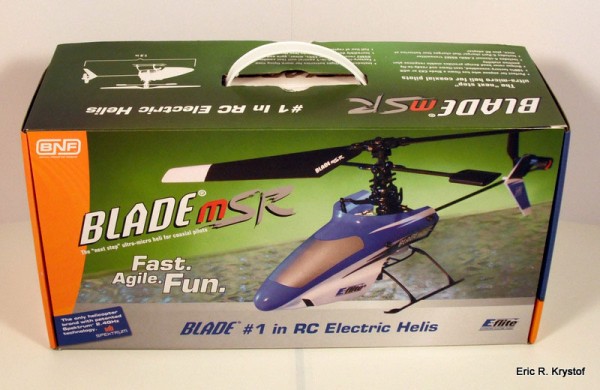
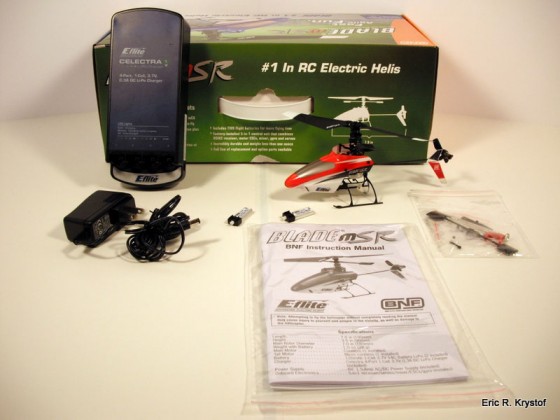
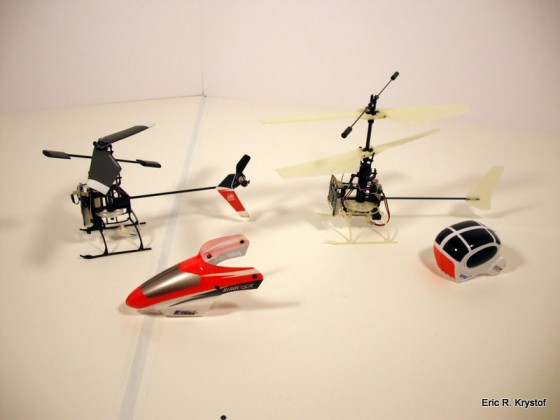
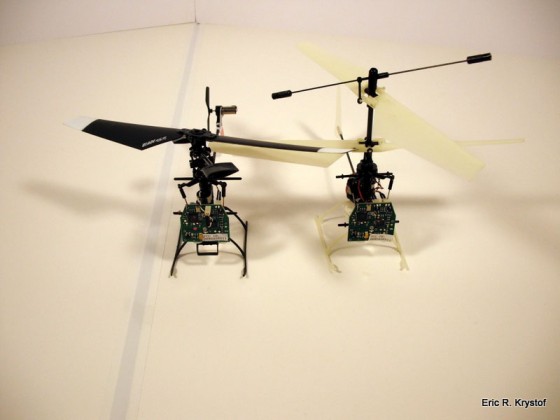

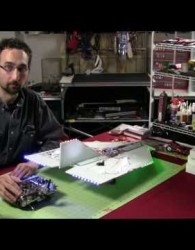
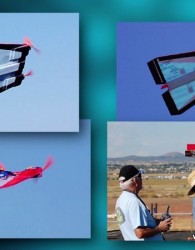
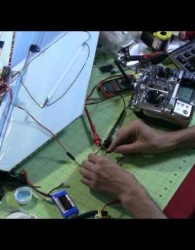













26 Comments
RICHARD F BARR
07/07/2011
precisely, and EXACTLY what I would have written about this tiny helicopter.
I’ll say this much : it has been A SPECIAL GIFT to carry me through this FLU confinement by staying inside and flying helicopters. ( he ! )
the advise on smooth, slow input is right ON
great job Mr. E.R. I look forward to your input in out BOB thread RICK
RICHARD F BARR
07/07/2011
second time around :
“for a little more oomph” as you say;
have you, or have you considered, moving the two connectors on the side of the swashplate from the short arm/ball to the long arm/ball
to improve the agility of the mSR ?
I would already like to do that but the SIZE of the components and how to reach to disconnect really discourages me.
Eric Krystof
07/07/2011
Rick,
I have not tried that. My mSR is at work right now locked away as I was showing it to a coworker who is interested in one, so I don’t have it in front of me at the moment. I’ll have to check it out to get a better look and let you know!
William
07/07/2011
Hi Eric,
I just ordered one of the Blade mSR’s and got a really good deal on it from ebay. $179.00 out of pocket no tax for the RTF version and it came with not two but 6, yes “SIX” battery’s, two of them are the stock 120mah and four are the superior Tenergy 130 mah versions. And yes it’s brand new in box with manufacturers warranty. I have only flown a coaxial micro heli three times and now I am addicted. It was one of the cheap $40. helis and no matte how much you adjusted the trim it just kept spinning in circles. I didn’t want to get a toy, I wanted something that I could have fun with but also had some realism to it and several reviews online led me to belive that the mSR would be the best choice for a beginner like my self. I was just wondering what your opinion is on beginning with the mSR and since I have already ordered it do you have any advice on flying it? Thank you for your time and Happy Holidays.
William C.
Eric Krystof
07/07/2011
William,
I think it’s a great helicopter for learning. Both the mCX and mSR are very stable and durable flyers (the mCX is E-Flight’s Coaxial, whereas the mSR is the Single-Rotor).
Those cheap little helis that run for 20-50 dollars are exactly what got me hooked earlier this year, and I hear you on the trim, they’re touchy and twitchy. The mCX and mSR, like any helicopter, will still need some trimming, but it’s MUCH easier to get them ‘dialed in’ than the cheapie little micro helis (get what you pay for – but they’re great for building addiction or stocking stuffers!)
It’s great that you got some souped up batteries for it as well, and with the charger you’re getting you’ll be charging four of them at the same time, I love that.
I agree, the mSR is a great step up from the $40 micro helis. Since you got the RTF version, you’ll have your own transmitter, which looks more like a handheld game controller than a programmable on like my Spektrum DX6i or DX7.
The transmitter you’ll have in your box will be just fine for your mSR. They use the same transmitter on RTF plane kits, and that’s where there are issues (dual rates/expo/etc. – I need to do a write up on that to explain it). But on the mSR, it’s not too bad, I’ve flown one with the RTF transmitter without any problems.
The advice I would give is that be gentle with the sticks. Your transmitter is not really adjustable like a DX6i or DX7, meaning you can’t control the how touchy your sticks are (think loose vs. tight steering on your car) by changing settings on your TX. So don’t jerk the controls all the way from center stick to the outer rims. Save that until you’ve had some practice, because the mSR will MOVE… FAST.
That’s the biggest difference you’re going to experience – coaxial helis are more stable than single rotors, but they don’t move around as fast. The mSR will be the opposite, although the stability in the mSR is pretty darn good.
When you first hover, try to keep the tail facing you, and just get used to moving it forward/back/left/right. Use your rudder control to keep the tail facing you. This lets you get used to the helicopter moving around, but keeping the same orientation (pointing away).
That’s called ‘tail-in’ hovering and is a preferred method of practice. You concentrate on throttle (keeping it hovering), and moving it back and forth, left and right, without worrying about it spinning.
Once you get comfy with that, then you can try what’s called ‘nose-in’ hovering. That is where you spin the helicopter so it’s facing you, but be careful – your controls are now completely reversed. Left is right, right is left, back is forward, forward is back. You’ll get used to it over time, but it sure sent my system into shock when I first tried it.
Given it’s so durable, it’s such a great flyer to learn basic helicopter orientation, hovering, and movement.
So, I suppose if I had to summarize this rant, I’d say…
1. Gentle on the sticks
2. Tail-In First, get used to how responsive your transmitter and heli are.
3. Nose-In next, get used to alternate orientations
4. Start flying patterns – figure 8’s, circles, etc.
Happy Holidays, and I hope you enjoy a great little heli that beats the living daylights out of it’s same size $40 micro cousins!
William
07/07/2011
Hi again Eric,
Thank you very much for the advice, I truly appreciate you taking the time to help a newbie like my self. You also used words that I could actually understand without getting too technical, big words come with this territory so thanks for dumbing it down a little. I will definitely be recommending your website to beginners like me but even experts could find it useful as well.
I have read several forums and reviews regarding the Spektrum DX6i and what a quantum leap it is in transmitter technology. I heard that by binding the DX6i to the mSR you can not only tame it down for training but you can dial it up for more advanced realistic flight that the stock transmitter couldn’t come close to. If this it true would it be a good investment for me to get one?
Well thanks for everything because in this Hobby we need all the help we can get. Take care and Happy Holidays.
Eric Krystof
07/07/2011
William,
My pleasure! You will come to find as you see more forums, sites, and articles on 2.4 GHz systems that it’s just like Chevy vs. Ford vs. Whatever. I personally went the Spektrum route, but plenty go the Futaba, JR, Hitec routes, etc.
I have not had any terribly major issues with Spektrum technology. The one time I lost all my settings, I also let the batterys drain completely out, and although I would NOT expect that to cause anything, at the same time I knowingly didn’t do something right either.
That small disclaimer aside, the DX-6i is an excellent transmitter, and although I have both (I primarily use a DX-7 because it handles 7 channels), the DX-6i will handle all the types of helicopters and airplanes. I gave one to my father and he uses it on his foamie flyers we built, his mSR, mCX, CX2 and ParkZone Vapor.
That’s the first great thing about a programmable transmitter like the DX-6i. It has 10 model memory, meaning if you use Spektrum DSM2 receivers on 10 different craft, you can bind them all to your one transmitter, without having to continuously buy the RTF kits (your current transmitter would then go to ‘backup’ land).
Given that you can bind multiple receivers to the one transmitter is a bonus, the programmable nature of the transmitter is a godsend. You can change settings like dual rate and expo, trim, throttle hold, and throttle and pitch curves. A lot of terms thrown out right there, but they really let you control how responsive (or even ‘numb’) your craft is. I’m working on making some beginner level write-ups on just those terms, hopefully in the next few weeks.
Would I purchase a DX-6i if the mSR was going to be my only craft EVER? No. The stock transmitter, although hard-configured with specific dual rates and what not, works fine, you’ll just need extra special stick handling that comes with practice. Then again, perhaps you really want all that control over the flight characteristics. Then, by all means, the DX-6i will work great.
If you’re thinking of getting another craft, like a ParkZone Vapor, P-51D Mustang Micro, Blade mCX, Blade CX2, Blade 400, etc. (or even make your own), then it’s a perfect transmitter to grow on. Just make sure whatever you buy supports Spektrum DSM2 technology, and it will match up just fine, and if you’re not sure, just ask any of us, or peeps at your L.H.S. and they’ll set you straight.
If you’re going to get a Spektrum TX, make sure it’s the DX-6i or DX-7. Not the DX5e or DX-7SE (Special Edition). They have limitations you don’t want to worry about.
See the list here: http://www.spektrumrc.com/DSM/Products/airRadios.aspx
A programmable transmitter like that is a great investment, it’s up to you whether you get your money’s worth out of it.
Johan
07/07/2011
Hey guy’s, I bought an smr today, its fantastic but one thing. The original transmitter that comes with, you can pusch the right handle down,towarts the transmitter, than the light on the transmitter blinks and you run in a beginners mode so the sticks reacts a lot smooter. (sorry for my englisch I’m from Belgium-Europe). If you don’t,it’s way to fast for small places.
Have fun
Johan
Eric Krystof
07/07/2011
Johan,
Thanks for that information! I don’t have the stock transmitter, and couldn’t remember what exactly the switch was for the two dual rates.
It’s great that it has at least one option to make it run smooth or not if you don’t have a programmable TX like the DX-6i.
William
07/07/2011
Hey Johan,
I was told by the guys at my LHS that the original transmitter comes stock in beginners mode and I believe one of the techs from E-Flite told me this as well. I also noticed that the mSR seems a little fast (Rookie pilot here) out of the box for indoors. My mSR has a bad servo so I’m waiting for a new board, should arrive Wednesday Dec 30th so I’ll give it a try let you know what happens. Thanks and Happy New Year!!!
Jerry
07/07/2011
Glad I stumbled across this writeup. I have a CX2, MCX, MSR and Vapor. I was using the xmtr from the CX2 and was constantly rebinding. Just got the DX6i and am learning to use it. Trying to setup the exponential. I’m a little “thumb-happy” and need to slow my responses down. What do you recommend for expo settings for MSR?
Eric Krystof
07/07/2011
Jerry,
It really comes down to feel, but a good starter could be 70% on your rates, and 20-30% on the expo.
The key is to get it to a stable hover, and then use each channel individually and tune as you go. The numbers above start you at a toned down base, then try spinning your rudder and adjust it specifically. Same for elevator and aileron.
We’ll be working on some advanced setup techniques with the the dx6i and dx7 in the next week or so, going over dual rates in detail, hopefully that helps. A lot of times though, when it comes to dual rates and expo, it comes down to what you’re comfortable with. Try 70% on low rate and 20% on expo and start there, let me know how it goes for you!
kd78
07/07/2011
I got a msr today and really love it. Takes some time to get it trimmed properly with the stock controller but its great after that.
My only issue is that the tail motor broke after just a few flights. Basically, the cap pops off the motor. I looked around and it looks like they are now shipping a redesigned motor which has more durability.
I am grounded until the replacement comes!
Eric Krystof
07/07/2011
kd78, Glad you’re enjoying it, though that’s the first I’ve heard of a tail motor breaking in that fashion. I assume Pops and I have one of the early models, we’ll have to keep an eye out on the motor caps, thanks for posting that!
William
07/07/2011
Johan and kd78,
Well Johan you were right, the stock mSR TX is set to High rates mode right out of the box. This is called a dual rate feature and like you said you can switch between high and low rates (or as I like to call them Advance and Beginner Mode)by pushing down on the right hand stick on the TX. When the red light on the TX is solid its in high rate (advance) mode, when its blinking its in low rate (beginner) mode. I highly recommend beginners to start out in the low rate (beginner) mode until you are comfortable with the controls. As for kd78’s problem on the tail motor I have read some forums and watched a utube video about that same problem. Basically when the tail rotor blade impacts something hard in a crash the rotor shaft gets pushed through the motor popping the out the back. One way to prevent this is to wrap self fusing rubber tape or heat shrink around the cap sealing it to the motor. I don’t suggest this because it will inhibit the brushed motor from cooling and shorten its life span. What I did was take the black cap off the end of the motor and sealed it back on with epoxy and its worked just fine. If you are a beginner and have an mSR I recommend getting some extra blade grips because they break pretty easily and will break eventually. Once you become comfortable with how it fly’s I recommend getting aluminum blade grips so you don’t have to worry about them breaking any more. The aluminum blade grips will most likely cause some TBE (toilet bowl effect)until they get broken in. This is why I don’t recommend them to a beginner because it will just make it harder to learn. Also when replacing the blade grips, plastic or aluminum, be sure no to loose the rubber O-rings and brass bushings that go on the feathering spindle. My mSR came with only one bushing and I ended up loosing it when replacing the blade grips and it caused my mSR to shake and vibrate in flight. If your mSR is missing any of those parts go to your local hobby shop and pick some up for around $3.00 you’ll be glad you did. In fact, if you enjoy flying your mSR like I do then I highly recommend having spare parts for every thing just in case. That way if (WHEN!) something dose brake you don’t have any down time other than the time spent repairing which I also enjoy. Well have fun flying and Happy New Year to all.
Remember, keep her steady in the air, not in pieces on the ground. William C.
Dynodon
07/07/2011
Love my Blade MSR, but I experienced a tail rotor failure as listed on the posts and also broke my landing skid. Unfortunately, both of these parts are on backorder. I live and work in China, so parts are a pain to get. How important is it to allign the main rotor, and can you give any tips doing so?
Eric Krystof
07/07/2011
I’ve never had to take the entire assembly apart, Dynodon, but it is important that it aligns the way it did before you disassembled it, primarily if you have to mess with the swash plate. There’s not a lot of adjustable parts with the mSR so it should be fairly easy, just annoying in that it’s such a small helicopter.
Now, taking a look at mine, I have a slight bend with the main shaft, and I don’t think that was necessarily there to begin with. Mine has been through a few rough landings from me trying stunts. You may want to order an extra main shaft if yours is off a bit and you’re concerned about the main rotor. As far as some of that dis-assembly and calibration, here’s a video example: http://www.youtube.com/watch?v=SYIaU0wAzqg
Mine has been through a few rough landings from me trying stunts. You may want to order an extra main shaft if yours is off a bit and you’re concerned about the main rotor. As far as some of that dis-assembly and calibration, here’s a video example: http://www.youtube.com/watch?v=SYIaU0wAzqg
Good luck, let us know how it goes!
Eric J
07/07/2011
Hi Eric K,
Thanks for the excellent review! I’m 6 months new to RC Helis and 4 months new to my Blade MSR.
I initially got hooked in December with a cheapie coaxial model that I later found out was a sister to Revell’s Proto. It was on sale at Christmas time for $80.00 BNF, however the true cost climbed quickly after crashes claimed 6 landing skids, 5 flybars, 2 inner shafts, 1 main frame, 1 upper blade set, 1 tail fin, 1 swashplate and one canopy.
Before spending another dime on this fragile, clumbsy, twitchy, B-minus creature, I bought a Blade MCX which has proved MUCH more durable, only falling victim to one damaged (not broken) landing skid and one inner shaft.
Taking the next step up to the MSR proved to be a very rocky start for me. I had “mastered” nose-in flight with my MCX and studied all of the MSR instruction I could find on the web. However, I never bothered to learn how to toggle the dual rate feature on the stock transmitter (note to self: fully read and understand included instructions!). I also failed to notice that my MSR came out of the box with the rotor/swashplate linkages set up in “advanced” mode. Lastly, I thought I understood what it meant not to go heavy on the stick – turns out I didn’t have a clue!
The first two weeks I was all over the place and couldn’t maintain control for more than than five or ten seconds. I grew so frustrated that I almost gave up and thought it was the silliest $150 I had ever spent. That entire time I had assumed it was set up in “beginner” mode. Once I switched the linkages to the beginner mode I was able to quickly catch on. A week later I was able to switch it back to “advanced” mode and now I can’t imagine flying any other way.
I’ve bought 4 additional Hyperion 130mah batteries and fly 4-5 hours every week. I’m quite surprised at how much I love flying and fixing this little thing. In the past, real cars and motorcycles were my passion which I could never fully delve into because of cost. Ultra-micro and micro electric helis are well within my budget and I love that a screw driver (included) and needle nose pliars (optional) are the only tools needed to remove and replace practically every part on the MSR.
My MSR appears even more durable than the MCX, but that hasn’t stopped this slow-learning, ham-fisted idiot from breaking 2 landing skids, a blade grip, 2 flybars, a mainframe and a 5-in-1 control unit.
Advice: Do not crash at full speed into a one-ton machine casting in a warehouse.
Happy trails,
Eric J.
Eric Krystof
07/07/2011
Eric J., (Oh this could get confusing )
)
I’m glad you enjoyed the write-up! Glad to see you got properly hooked with a more stable mCX than the Revell Proto.
The D/R toggle has zinged a few people, so you’re not alone! It’s a constant struggle for me – read everything and then fly, or just go out and fly it, maybe browse. I usually pay for it when I only browse.
That’s the perfect way to get used to the mSR as well, hopefully other beginners follow suit. No shame in starting out with small rates. Gotta get the feel for it, and then you’ll never go back once you are ready for ‘high gear’. Glad that worked out for you! Plus, you can’t beat that four port charger!
The nice thing about Omaha is that we have parts available locally at HobbyTown, should we need a new blade grip or whatnot.
I will take your advice to heart, and stay away from any one-ton machine castings in warehouses. I didn’t have that on my list of ‘things not to crash into’, so luckily I’ve got that one down on said list now.
Have fun with the mSR, Pops and I have both enjoyed ours and it’s a great way to learn basic helicopter maneuvers as you work your way up (if you want to) to larger helicopter action.
I have to say the best thing about it is that although some recommend a 400+ size helicopter to learn on (blades as long as a small/medium size lawnmower) – because they’re heavier and more stable – the mSR is an exception to that rule due to its stability. I’m glad it’s there to fill that niche, because a lot of people think ‘start small’, and that can sometimes be an issue in regards to stability, thankfully the mSR fits that role nicely.
Fuzzy
07/07/2011
Sweet,especially the father and son connection
Eric Krystof
07/07/2011
Thanks, Fuzzy. I took part of that video to further exploit that father and son connection in Dad’s numerous decapitation attempts, you might enjoy that as well, was a fun video to make.
http://www.hoverandsmile.com/semi-great-moments-in-parent-to-child-attempted-rc-decapitation-history/
Ed
07/07/2011
Great article and thanks for all the tips.
Once small note – the manufacturer is “E-Flite” not “E-Flight”. Might help more people find your article with the correct spelling.
Hugh
07/07/2011
Hi, I have a fix, my MSR was not trimming correctley after being correct so I brought it to Lee he showed me when holding MSR and spinning blades main blade looked like 2 blades should look like 1. Fix was main blade grips 2 pieces that hold blade had hair line cracks look like white lines at joints. He did repair but nothing I could not have done knowing what was wrong 4 small screws and new part $4.00 back to having good times almost not crashing only 1 month old. hope this helps someone. Thanks Hugh
Eric Krystof
07/07/2011
Ed and Hugh, thanks much for the additional comments, and I changed the spelling… How thick I must have been when writing that article!
Greg
07/07/2011
When I first flew the MSR [my first time ever with a heli], I tried hovering it about 8” off the table and coudn’t control it. This was due to the downwash of air from the helicopter blades bouncng off the table and affecting the performance. So I recommend that any beginner take the MSR up at least two feet to get the hang of flying the aircraft and trimming it.
Eric Krystof
07/07/2011
Good call Greg, prop wash is a killer, from ground or wall effects.
That’s the unfortunate thing about helis no matter the size – there is a point of no return, you can only take a heli a certain ‘gentle’ amount up before you have to give it the juice and go for it.
As soon as it starts to tip, you have to commit to the take off or spool it down. Same with once it’s up – get it up, since a foot or less off the ground makes the heli fly worse from the prop wash you mentioned.
No trackbacks yet.